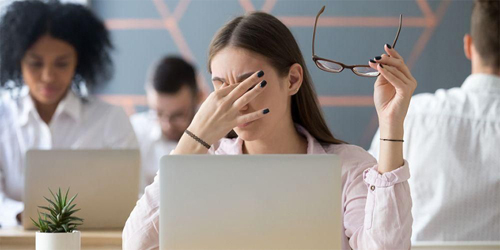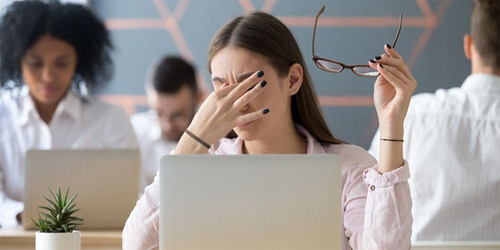What is Digital Eye Strain?
Many of us have found ourselves using our digital devices more and more: working from home, completing online school, and keeping in touch with family and friends has made us more reliant than ever on our smartphones, tablets, and computers.
But you may have noticed that prolonged screen time can sometimes be hard on the eyes. Digital eye strain, or computer vision syndrome, is a group of eye and vision problems that result from increased digital screen use. But what exactly is digital eye strain, and what can you do to remedy its effects?

Symptoms of Digital Eye Strain
Viewing text on a digital device is a little different than reading a printed page: glares and reflections, certain typefaces, and varying levels of contrast all make your eyes work harder to focus. Over time, this can lead to digital eye strain. Symptoms include:
- Eye fatigue
- Headaches
- Blurry vision
- Dry or watery eyes
- Increased light sensitivity
- Neck and shoulder pain

Eye drops seem like an easy fix for this problem, but when you put all these symptoms together, it becomes a little more complicated. If you’re experiencing computer vision syndrome, there are several other strategies you can employ to minimize your discomfort and preserve your eye health.
What Can You Do About Digital Eye Strain?
The 20-20-20 Rule
The 20-20-20 rule is recommended by the American Optometric Association as a way to prevent digital eye strain symptoms. The rule is simple: while using your devices, you should stop every 20 minutes and focus on an object 20 feet away for 20 seconds. That’s all there is to it!
The idea is to help you remember to blink more, stretch, and change position during repetitive work. Try setting a timer on your phone for every twenty minutes the next time you’re working or doing homework at your computer — you’ll be surprised how much a very short break will help your eyes.
Specialty Lenses
Our devices emit blue light, which has sometimes been linked to an interruption in our body’s circadian rhythm, or internal clock. Blue light glasses can help to filter out blue light for a more comfortable viewing experience, and anti-blue-light coatings on your prescription lenses are also an option.
Furthermore, glare and reflections on your screen can strain your eyes. Lenses with anti-reflective coating are available in prescription and non-prescription varieties and can help to alleviate the symptoms of digital eye strain.
Addressing Digital Eye Strain in Minnesota & North Dakota
The best way to diagnose and find an effective treatment for this condition is during a comprehensive eye exam, where your eye doctor will assess your vision and evaluate the overall health of your eyes. If you’re exhibiting symptoms of computer vision syndrome, request an appointment at Midwest Vision Centers today!
